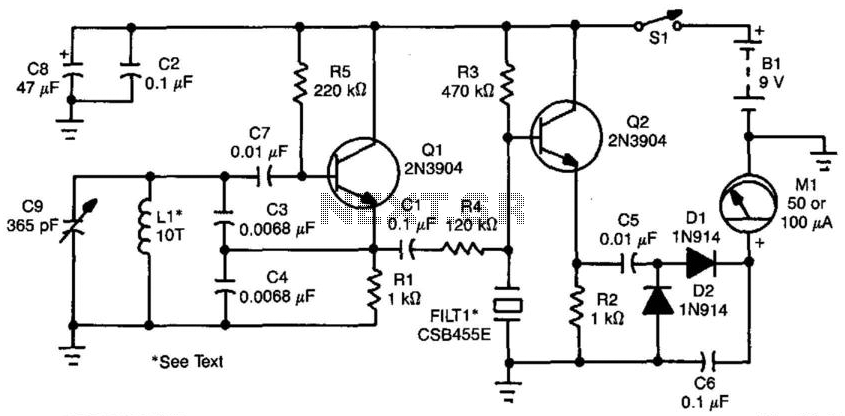
Ionization chamber smoke detector II

The smoke alarm signal must be continuous rather than pulsating; therefore, the slightly less expensive all-discrete transistor version of the MC14572 may be utilized.
The MC14572 is a versatile integrated circuit commonly used in smoke detection systems. This device is designed to generate a continuous alarm signal, which is crucial for effective smoke detection. The requirement for a continuous signal ensures that the alarm is easily recognizable and does not cause confusion in emergency situations, as a pulsating signal might.
In applications where cost is a concern, the all-discrete transistor version of the MC14572 offers a more economical alternative while still retaining the essential functionality required for smoke detection. This version comprises discrete components that can be configured to replicate the behavior of the integrated circuit, providing a reliable solution for smoke alarm systems.
The circuit typically includes a sensing element that detects smoke particles in the air, which triggers the alarm signal. The signal can be amplified using additional discrete transistors to ensure it reaches an adequate volume level for audible alarms. Furthermore, the design may incorporate a resistor-capacitor (RC) timing circuit to maintain the continuous nature of the alarm signal, preventing it from transitioning to a pulsating state.
When implementing this circuit, it is essential to ensure proper power supply decoupling and layout to minimize noise and interference, which could affect the performance of the smoke alarm. Overall, utilizing the all-discrete version of the MC14572 can provide a cost-effective and reliable solution for smoke detection applications.The smoke alarm signal must be a continuous one rather than pulsating, then the slightly less expensive all discrete transistor version of the MC14572 may be used.
The MC14572 is a versatile integrated circuit commonly used in smoke detection systems. This device is designed to generate a continuous alarm signal, which is crucial for effective smoke detection. The requirement for a continuous signal ensures that the alarm is easily recognizable and does not cause confusion in emergency situations, as a pulsating signal might.
In applications where cost is a concern, the all-discrete transistor version of the MC14572 offers a more economical alternative while still retaining the essential functionality required for smoke detection. This version comprises discrete components that can be configured to replicate the behavior of the integrated circuit, providing a reliable solution for smoke alarm systems.
The circuit typically includes a sensing element that detects smoke particles in the air, which triggers the alarm signal. The signal can be amplified using additional discrete transistors to ensure it reaches an adequate volume level for audible alarms. Furthermore, the design may incorporate a resistor-capacitor (RC) timing circuit to maintain the continuous nature of the alarm signal, preventing it from transitioning to a pulsating state.
When implementing this circuit, it is essential to ensure proper power supply decoupling and layout to minimize noise and interference, which could affect the performance of the smoke alarm. Overall, utilizing the all-discrete version of the MC14572 can provide a cost-effective and reliable solution for smoke detection applications.The smoke alarm signal must be a continuous one rather than pulsating, then the slightly less expensive all discrete transistor version of the MC14572 may be used.





